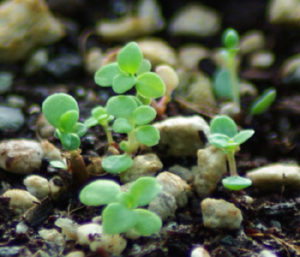
Young rhodiola seedlings grow slowly, and do better in a location semi-sheltered from sun and wind. They grow slowly, suffering both when the soil remains saturated with moisture for extended periods and when the soil becomes very dry. Thus a balance between overwatering and drought conditions should be maintained. Mild fertilization may be beneficial, but is not required. After a month or two, when a stalk is sent up from the rosette of seed leaves, seedlings can be exposed to more sun to maximize growth. Seedlings can be transplanted in their first year, but can also be kept in plug trays for a year or two to minimize weeding in the field. Excellent transplant survival rates can be achieved any time the ground is not frozen, even with dormant (leafless) plugs in the fall. Eventually plant growth will suffer if seedlings are not planted out.
Ideal growing site components include full or almost full sun, good drainage during the spring runoff and some shelter from the wind. While the latter
Time to harvest can be as short as three growing seasons, when roots can attain 0.75% rosavin content or better, though four to five year’s growth will provide greater root biomass and a rosavin content of 1% or more. The roots tend to deteriorate from within as they age, harboring patches of necrotic tissue (or “heart-rot”) to which they will eventually succumb. The upshot is that – while there may be 75-year old plants in the wild – the maximum age of a commercial field may only be six or seven years. The dynamics of root attrition due to disease are not yet understood, and may differ with various cultivars and soil conditions. Initial indications are that fertilization is not beneficial under normal conditions.
R. rosea is an adaptable species, and as such appears to do well in a variety of soil types, from rocky gravel through heavy clay to silty, sandy and peaty loam soil types. The relationship between soil pH and rosavin levels is presently poorly understood, but may favor acidity – ? As a circumpolar species, Rhodiola does well at high latitudes, where its production of rosavins assists survival under harsh conditions. How it performs in warmer climates will be an interesting experiment.